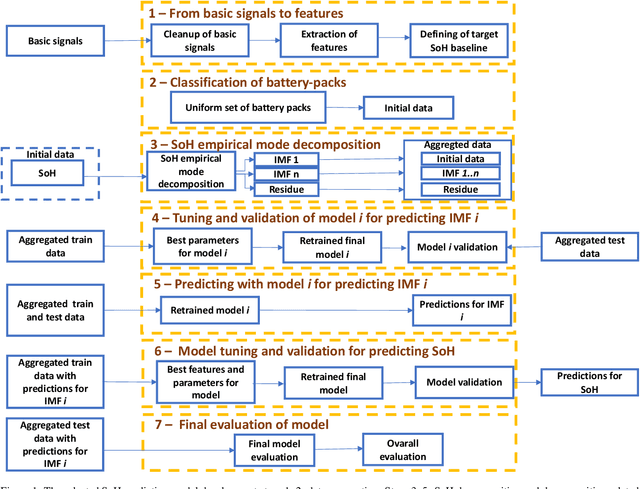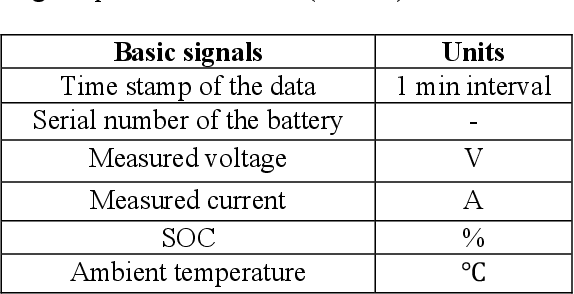Avleen Malhi
Citizen participation: crowd-sensed sustainable indoor location services
Oct 25, 2023Abstract:In the present era of sustainable innovation, the circular economy paradigm dictates the optimal use and exploitation of existing finite resources. At the same time, the transition to smart infrastructures requires considerable investment in capital, resources and people. In this work, we present a general machine learning approach for offering indoor location awareness without the need to invest in additional and specialised hardware. We explore use cases where visitors equipped with their smart phone would interact with the available WiFi infrastructure to estimate their location, since the indoor requirement poses a limitation to standard GPS solutions. Results have shown that the proposed approach achieves a less than 2m accuracy and the model is resilient even in the case where a substantial number of BSSIDs are dropped.
Comparing seven methods for state-of-health time series prediction for the lithium-ion battery packs of forklifts
Jul 06, 2021



Abstract:A key aspect for the forklifts is the state-of-health (SoH) assessment to ensure the safety and the reliability of uninterrupted power source. Forecasting the battery SoH well is imperative to enable preventive maintenance and hence to reduce the costs. This paper demonstrates the capabilities of gradient boosting regression for predicting the SoH timeseries under circumstances when there is little prior information available about the batteries. We compared the gradient boosting method with light gradient boosting, extra trees, extreme gradient boosting, random forests, long short-term memory networks and with combined convolutional neural network and long short-term memory networks methods. We used multiple predictors and lagged target signal decomposition results as additional predictors and compared the yielded prediction results with different sets of predictors for each method. For this work, we are in possession of a unique data set of 45 lithium-ion battery packs with large variation in the data. The best model that we derived was validated by a novel walk-forward algorithm that also calculates point-wise confidence intervals for the predictions; we yielded reasonable predictions and confidence intervals for the predictions. Furthermore, we verified this model against five other lithium-ion battery packs; the best model generalised to greater extent to this set of battery packs. The results about the final model suggest that we were able to enhance the results in respect to previously developed models. Moreover, we further validated the model for extracting cycle counts presented in our previous work with data from new forklifts; their battery packs completed around 3000 cycles in a 10-year service period, which corresponds to the cycle life for commercial Nickel-Cobalt-Manganese (NMC) cells.
* 16 pages, 10 figures and 10 tables
Explainable Artificial Intelligence for Human Decision-Support System in Medical Domain
May 05, 2021



Abstract:In the present paper we present the potential of Explainable Artificial Intelligence methods for decision-support in medical image analysis scenarios. With three types of explainable methods applied to the same medical image data set our aim was to improve the comprehensibility of the decisions provided by the Convolutional Neural Network (CNN). The visual explanations were provided on in-vivo gastral images obtained from a Video capsule endoscopy (VCE), with the goal of increasing the health professionals' trust in the black box predictions. We implemented two post-hoc interpretable machine learning methods LIME and SHAP and the alternative explanation approach CIU, centered on the Contextual Value and Utility (CIU). The produced explanations were evaluated using human evaluation. We conducted three user studies based on the explanations provided by LIME, SHAP and CIU. Users from different non-medical backgrounds carried out a series of tests in the web-based survey setting and stated their experience and understanding of the given explanations. Three user groups (n=20, 20, 20) with three distinct forms of explanations were quantitatively analyzed. We have found that, as hypothesized, the CIU explainable method performed better than both LIME and SHAP methods in terms of increasing support for human decision-making as well as being more transparent and thus understandable to users. Additionally, CIU outperformed LIME and SHAP by generating explanations more rapidly. Our findings suggest that there are notable differences in human decision-making between various explanation support settings. In line with that, we present three potential explainable methods that can with future improvements in implementation be generalized on different medical data sets and can provide great decision-support for medical experts.
Towards a Rigorous Evaluation of Explainability for Multivariate Time Series
Apr 06, 2021



Abstract:Machine learning-based systems are rapidly gaining popularity and in-line with that there has been a huge research surge in the field of explainability to ensure that machine learning models are reliable, fair, and can be held liable for their decision-making process. Explainable Artificial Intelligence (XAI) methods are typically deployed to debug black-box machine learning models but in comparison to tabular, text, and image data, explainability in time series is still relatively unexplored. The aim of this study was to achieve and evaluate model agnostic explainability in a time series forecasting problem. This work focused on proving a solution for a digital consultancy company aiming to find a data-driven approach in order to understand the effect of their sales related activities on the sales deals closed. The solution involved framing the problem as a time series forecasting problem to predict the sales deals and the explainability was achieved using two novel model agnostic explainability techniques, Local explainable model-agnostic explanations (LIME) and Shapley additive explanations (SHAP) which were evaluated using human evaluation of explainability. The results clearly indicate that the explanations produced by LIME and SHAP greatly helped lay humans in understanding the predictions made by the machine learning model. The presented work can easily be extended to any time
Building Safer Autonomous Agents by Leveraging Risky Driving Behavior Knowledge
Mar 31, 2021



Abstract:Simulation environments are good for learning different driving tasks like lane changing, parking or handling intersections etc. in an abstract manner. However, these simulation environments often restrict themselves to operate under conservative interactions behavior amongst different vehicles. But, as we know that the real driving tasks often involves very high risk scenarios where other drivers often don't behave in the expected sense. There can be many reasons for this behavior like being tired or inexperienced. The simulation environments doesn't take this information into account while training the navigation agent. Therefore, in this study we especially focus on systematically creating these risk prone scenarios with heavy traffic and unexpected random behavior for creating better model-free learning agents. We generate multiple autonomous driving scenarios by creating new custom Markov Decision Process (MDP) environment iterations in highway-env simulation package. The behavior policy is learnt by agents trained with the help from deep reinforcement learning models. Our behavior policy is deliberated to handle collisions and risky randomized driver behavior. We train model free learning agents with supplement information of risk prone driving scenarios and compare their performance with baseline agents. Finally, we casually measure the impact of adding these perturbations in the training process to precisely account for the performance improvement attained from utilizing the learnings from these scenarios.
A Dynamic Battery State-of-Health Forecasting Model for Electric Trucks: Li-Ion Batteries Case-Study
Mar 30, 2021



Abstract:It is of extreme importance to monitor and manage the battery health to enhance the performance and decrease the maintenance cost of operating electric vehicles. This paper concerns the machine-learning-enabled state-of-health (SoH) prognosis for Li-ion batteries in electric trucks, where they are used as energy sources. The paper proposes methods to calculate SoH and cycle life for the battery packs. We propose autoregressive integrated modeling average (ARIMA) and supervised learning (bagging with decision tree as the base estimator; BAG) for forecasting the battery SoH in order to maximize the battery availability for forklift operations. As the use of data-driven methods for battery prognostics is increasing, we demonstrate the capabilities of ARIMA and under circumstances when there is little prior information available about the batteries. For this work, we had a unique data set of 31 lithium-ion battery packs from forklifts in commercial operations. On the one hand, results indicate that the developed ARIMA model provided relevant tools to analyze the data from several batteries. On the other hand, BAG model results suggest that the developed supervised learning model using decision trees as base estimator yields better forecast accuracy in the presence of large variation in data for one battery.
* This paper has first been published at the Proceedings of the ASME 2020 International Mechanical Engineering Congress and Exposition IMECE2020 held on November 16-19, 2020, Portland, OR, USA
 Add to Chrome
Add to Chrome Add to Firefox
Add to Firefox Add to Edge
Add to Edge